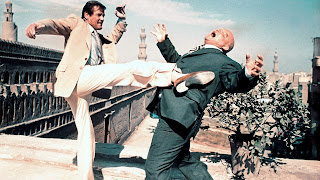 In the late 20's and early 30's the mountains of Franklin County, Virginia where so rife with bootleggers that at night the fires from the stills lit up the mountains like fireflies. This is the setting for John Hillcoat's new film Lawless. It centers on the area’s most infamous moonshiners, the three Bondurant brothers.
In the late 20's and early 30's the mountains of Franklin County, Virginia where so rife with bootleggers that at night the fires from the stills lit up the mountains like fireflies. This is the setting for John Hillcoat's new film Lawless. It centers on the area’s most infamous moonshiners, the three Bondurant brothers.The leader is Forrest (Tom Hardy), a hulking man who, in Goodfallas parlance, doesn't have to move for anybody. Jason Clarke plays Howard, the muscle of the group. When Forrest says "sick 'em," Howard sicks 'em. Sometimes he does it when he hasn't been told. I guess stump whiskey does that to a man. The youngest is the put upon lookout, Jack (Shia LeBeouf). Over the years, a legend has grown up around the three boys, particularly Forrest, that they are invincible.
Of course, the problem with being invincible is that people are going to want to test that. In comes a special deputy named Charlie Rakes (Guy Pierce). Rakes is an odd man with his shaved eyebrows and a 3 inch gap in his hair part. His goal isn’t to stop the bootleggers but rather to extort a toll from them. The Bondurant’s refuse and face an all out war with Rakes and his small army of cops and hired thugs.
This all plays out predictably right down to the “look how well we’re doing” montage of the Brothers solidifying their rural empire. Still, Hillcoat and screenwriter Nick Cave (he also provides the soundtrack) create a striking sense of immediacy here. This isn’t some generic, homogenized vision of the late 20’s, this feels like the real thing. The roosters fighting in the yard, the fog rolling in over the giant willow trees, and the Bell brand jars the Bondurant brothers use to store their White Lightning whiskey are all little details that help the film live and breathe.
The ensemble do a mostly commendable job. Hardy’s mono-syabic performance is menacing and weirdly warm at the same time. Jessica Chastain does some nice work with her underwritten character, and Guy Pearce’s is a very cartoonish villain, but holds back just enough to keep from going off the rails. Shia LeBeouf on the other hand is just okay; he’s made leaps in his acting ability, but not bounds. It looks as if we're going to be stuck with LeBeouf as a leading man for a while, but he's yet to demonstrate that he's earned that privilege.
The absolute best thing about the film is the exquisite soundtrack put together by Cave and Warren Ellis. The two rockers have provided moody instrumentals for several of Hillcoats other movies but here the pair have put together a house band, The Bootleggers, and have created one of the best roots soundtracks since O Brother Where Art Thou. The band, with the help of guest stars like Ralph Stanley and Emmylou Harris, cover a wide array of songs by Link Wray, John Lee Hooker and even The Velvet Underground, while throwing in a few originals too. It’s a slam-bang soundtrack that oozes personality form every note.
Lawless is a solid crime film held back by it’s own formula and a mediocre lead performance. However the verisimilitude with which the period, not to mention the violence, is portrayed coupled with a fantastic soundtrack help balance out the flaws. At the very least you should pick up the album.
Grade: B
Here's a sample of The Bootleggers cover of Link Wray's "Fire and Brimstone"










